Excellent publications so far
Excellent publications so far
With a scientific publication, also known as a paper, scientists publish their own research topic in writing in specialist journals in order to share their research openly and verifiably with other colleagues. With the "Hermine Heusler-Edenhuizen Prize", the School VI Medicine and Health Sciences honours outstanding work by its young scientists.
For this purpose, applicants prepare a concise and comprehensible presentation of their newly acquired knowledge and submit it to forschungspool@uol.de. A committee of the School VI Medicine and Health Sciences selects the winner from all submitted applications and publications.
The prize is sponsored by the Friends and Sponsors of the University Medicine Northwest e.V .
Hermine Heusler-Edenhuizen Prize - in the early career phase 2023
Dr. Alexander Fassmer

Title of the publication: "Hospitalisation of German and Dutch Nursing Home Residents Depend on Different Long-Term Care Structures: A Systematic Review on Periods of Increased Vulnerability" Authors: Dr Alexander M. Fassmer, Dr Katharina Allers, Jasmin Helbach, Prof. Dr Sytse Zuidema,Prof. Dr Michael Freitag, Prof. Dr Tania Zieschang, Prof. Dr Falk Hoffmann
Division, Department or University Hospital: Department of Health Services Research, Division of Outpatient Care and Pharmacoepidemiology
Journal: Fassmer et al_JAMDA_ 2023
Summary of background, research question and significance of the publication: With demographic change, the number of people in need of care is also increasing. An increasing proportion of the population is dying in nursing homes. Due to poor health, nursing home residents have an increased need for medical care. This often results in hospital transfers, many of which are considered potentially avoidable. Previous literature suggests that these transports are particularly frequent in Germany. It also indicated that this care problem does not exist in this form in our Dutch neighbours.
For this reason, the Cross-Border Institute of Healthcare Systems and Prevention (CBI) conducted a systematic comparison of the existing evidence on hospital admissions of German and Dutch nursing home residents. The focus was placed on particularly vulnerable phases, i.e. the first six months after institutionalisation and the last six months of life.
This study showed that German nursing home residents are hospitalised much more frequently than Dutch residents in all the periods examined. While in Germany approximately every second nursing home resident is hospitalised at least once in the last month of life, in the Netherlands the figure is only 8.0-15.7%. In addition, nursing home residents in Germany are also more likely to die in hospital (28.9-29.5% vs. 1.0-16.3% in the Netherlands). Meanwhile, the characteristics of the underlying nursing home populations hardly differed from one another. For the first time, a team of authors then compared key figures from the two health and care systems and discussed various factors that could be responsible for these differences in hospital transfers: Organisation of medical care in nursing homes, handling of residents' care wishes (living wills, advance care planning) and societal views on ageing and end-of-life care. The work underlines the relevance of the topic and was the basis for further research carried out in this German-Dutch co-operation project.
About the award winner: Alexander Maximilian Fassmer studied Public Health (B.Sc. and M.A.) at the University of Bremen. He is a research assistant in the Department of Outpatient Care and Pharmacoepidemiology at the University Medicine Oldenburg and completed his dissertation on hospital transports from inpatient geriatric care facilities on 27 August 2021 (Dr. rer. medic.).
Hermine Heusler-Edenhuizen Prize - in the established career phases 2022
Dr. Christian Keine

Title of the publication: "Presynaptic Rac1 controls synaptic strength through the regulation of synaptic vesicle priming" Authors: Christian Keine, Mohammed Al-Yaari, Tamara Radulovic, Connon I. Thomas, Paula Valino Ramos, Debbie GuerreroGiven, Mrinalini Ranjan, Holger Taschenberger, Naomi Kamasawa and Samuel M. Young, Jr.
Division, Department or University Hospital: Department for Human Medicine, Research Centre Neurosensory Science
Journal: Keineet al_eLife_ 2022.pdf
Summary of background, research question and significance of the publication: The release of synaptic vesicles (SVs) from the presynaptic terminal is the basis of neuronal communication. The timing of SV release is critical for accurately and consistently transmitting neuronal information. Since the presynaptic terminal contains only a limited number of SVs, balancing release and replenishment is essential in maintaining synaptic transmission over prolonged periods of time and a wide range of neuronal activities. Presynaptic actin is crucial for synaptic transmission, but how presynaptic regulators of actin signalling cascades control SV release and replenishment remains unresolved. Rac1, a Rho GTPase, controls actin signalling cascades that regulate synaptogenesis and neuronal development, however, Rac1's role in regulating synaptic transmission is unknown. Notably, Rac1 mutations are linked to intellectual disability. To investigate the roles of presynaptic Rac1 in the regulation of transmitter release while avoiding interference with its role in synaptogenesis, axon guidance, and neuronal development, we selectively deleted Rac1 in the calyx of Held presynaptic terminal in adult mice. Loss of Rac1 increased synaptic strength, accelerated SV recovery after conditioning stimulus trains, and augmented spontaneous SV release while having no effect on presynaptic morphology or AZ ultrastructure. To gain mechanistic insight, we fitted the experimental data to different SV pool models and found that loss of presynaptic Rac1 increases SV priming kinetics and, depending on model assumptions, elevates SV release probability or the number of fusioncompetent SVs. This study demonstrates that presynaptic Rac1 regulates SV priming and SV release probability independently of its role in neuronal development and will help to better understand how synaptic transmission is altered in neuronal circuits associated with neurological disorders and addiction.
About the award winner: Christian Keine received a Ph.D. from the University of Leipzig studying neuronal inhibition in signal transmission. He then pursued a Postdoc at the Max Planck Florida Institute for Neuroscience and the University of Iowa investigating the role of presynaptic proteins on synaptic transmission.
Hermine Heusler-Edenhuizen Prize - winter semester 2022/2023
Natalie Gray

Title of the publication: "Differential Upregulation and Functional Activity of S1PR1 in Human Peripheral Blood Basophils of Atopic Patients". Authors: Natalie Gray, Maren M. Limberg, Daniela Wiebe, Tobias Weihrauch, Anna Langner, Nicola Brandt, Anja U. Bräuer and Ulrike Raap. Division, Department or University Hospital: Department for Human Medicine, Division of Experimental Allergology and Imundermatology and Department of Anatomy
Journal: https://pubmed.ncbi.nlm.nih.gov/36555755
Summary of background, research question and significance of the publication: Basophil granulocytes are important effector cells in allergic diseases such as atopic dermatitis (AD), as they recognise allergens through receptor-bound IgE antibodies, which triggers the degranulation of these cells. This releases pro-inflammatory cytokines, which initiate the inflammatory cascade and recruit other immune cells such as eosinophil granulocytes and T cells. Sphigosine-1-phosphate (S1P) is a lipid mediator that binds to five different S1P receptors (S1PR) and whose signalling cascade plays an important role in various biological processes.
Elevated S1P levels have been found in both AD and allergic asthma, which is why we wanted to investigate the interaction between the basophils, which are important in these diseases, and the lipid S1P in more detail. This paper is the first publication to investigate the interaction between basophils and S1P. We were the first research team to show that basophils express four S1P receptors and can therefore interact with S1P. We were also able to show that the stimulation of basophils with different concentrations of S1P influences both the lifespan and the chemotactic migration of the cells. The pathological concentration of 10 µM promotes cell apoptosis and basophils from atopic patients respond with a reduced level of cell migration. This could be related to the observed lower protein expression of S1PR1. These results suggest that the increased S1P levels in atopic diseases limit the number of basophils and thus counteract an exacerbation of the local inflammatory response. This opens up a new perspective on the role of S1P in atopic diseases. Until now, this lipid was considered to be rather pro-inflammatory, but by limiting basophils it also seems to have an anti-inflammatory effect. We also demonstrated for the first time that basophils in the tissue of an AD patient possess intracellular S1P. When released, this could influence the number and survival of basophils through self-regulatory mechanisms. Further research is needed as this could represent a new and interesting aspect of atopic pathogenesis.
About the award winner: Natalie Gray, born on 15 February 1995, has been employed as a doctoral student and research assistant in the Departments of Experimental Allergology and Immunodermatology and Anatomy since February 2020. There she is researching the interaction between sphingosine-1-phosphate and basophil granulocytes. She previously completed her Master's degree in Molecular Medicine at Trinity College in Dublin.
Hermine Heusler-Edenhuizen Prize - summer semester 2022:
Anna Brinkmann

Title of the publication: "Providing physical relief for nurses by collaborative robotics" Authors: Anna Brinkmann, Conrad Fifelski-von Böhlen, Christian Kowalski, Sandra Lau, Ole Meyer, Rebecca Diekmann, Andreas Hein
Department, Department or University Hospital: Department of Assistance Systems and Medical Technology, Department of Health Services Research, Department of Geriatrics, Department of Health Services Research
Journal: https://doi.org/10.1038/s41598-022-12632-4
Summary of the background, research question and significance of the publication: Employees in care professions are exposed to above-average mental and physical work demands, which can lead to musculoskeletal complaints and degenerative musculoskeletal disorders. This results in job-specific incapacity to work and people leaving the profession before retirement age. These factors have a serious impact on the prevailing discrepancy between the acute shortage of skilled labour and the increasing number of people in need of care - due to demographic change and COVID-19.
Repositioning processes in the care bed are among the physical health risks of everyday care work, which are carried out every two to three hours - often without taking ergonomic practices or the use of aids into account. New approaches and technologies for physical relief are urgently needed to improve the prevailing working conditions. Collaborative robotic systems represent a way to adaptively support conventional work processes based on sensory perception of the environment.
Our work is the world's first experimental study to quantify the potential of collaborative robotics to relieve the physical strain on carers. In the nursing laboratory at the University of Oldenburg, a patient simulation mannequin (80 kg) was moved from the supine to the lateral position in the nursing bed, based on ethical and technical requirements. The repositioning was carried out through targeted collaboration between the nursing staff and the robotic system. A measurement and analysis system recorded the movement and muscle activity data of the carers in order to derive the preparation and interaction strategies in the care process and to quantify the relief potential. The use of the robotic system reduced the maximum effort required in the care process by up to 51%. Highly asymmetrical postures and movements during repositioning corresponded with pronounced maxima in the muscle activity data of the lower limbs and spine and were reduced by up to 87%. This led to a significant reduction in average muscle activity in the spine (55%).
In summary, the presented work demonstrates for the first time the feasibility of robot-assisted patient handling and lays the foundation for future research. It underlines the need for interdisciplinary research to analyse the robotic system's sensory perception of the environment in order to respond adaptively to the individual needs and functional abilities of caregivers.
About the award winner: Anna Brinkmann studied Medical Technology (B.Sc.) and Human Technology in Sports and Medicine (M.Sc.) in Bremerhaven, Cologne and Istanbul. She is an employee of the Department of Assistance Systems and Medical Technology at the University of Oldenburg and defended her dissertation "Biomechanical analysis of nursing tasks for physical relief by collaborative robotics" on 23 September 2022 (Dr. rer. nat.).
Hermine Heusler-Edenhuizen Prize - winter semester 2021/2022:
Dr. Janina Noster
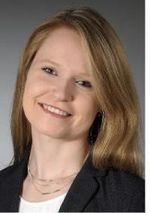
Title of the publication: "Bloodstream Infections Caused by Magnusiomyces capitatus and Magnusiomyces clavatus: Epidemio-logical, Clinical, and Microbiological Features of Two Emerging Yeast Species" Authors: Janina Noster, Martin B. Koeppel, Marie Desnos-Olivier, Maria Aigner, Oliver Bader, Karl Dichtl, Stephan Göttig, Andrea Haas, Oliver Kurzai, Arthur B. Pranada, Yvonne Stelzer, Grit Walther, Axel Hamprecht
Division, Department or University Hospital: University Institute of Medical Microbiology and Virology, Department for Human Medicine
Journal: Antimicrobial agents and chemotherapy (2021), Vol. 66 No. 2, AAC-01834
Summary of background, research question and significance of the publication: Bloodstream infections with rare yeasts such as Magnusiomyces spp. (formerly) represent a major challenge in diagnosis and therapy. The differentiation of the two most common species Mag-nusiomyces clavatus and Magnusiomyces capitatus with the biochemical methods used to date is not possible and the true epidemiology of these infections is unknown. Due to intrinsic resistance to many antimycotics (e.g. echinocandins), mortality from infections with these pathogens remains very high, despite modern antifungal chemotherapies. To date, only a few studies on the epidemiology and antifungal susceptibility of these pathogens have used reference methods for identification and resistance testing.
In our work, we collected isolates from a total of 34 bloodstream infections with M. clavatus and M. capitatus from seven institutions in Germany and Austria over a period of almost 20 years. Thanks to molecular and mass spectrometric identification methods, we were able to show that infections in Germany were much more frequently caused by M . clavatus , in contrast to most previously published data, which were not obtained using molecular biological reference methods. The majority of infections (79%) in our study occurred in patients with underlying haemato-oncological diseases. We analysed the susceptibility of these isolates to eight different antifungal agents using the gold standard method of broth microdilution; voriconazole and posaconazole showed the best in vitro efficacy. We also compared these results with the frequently used gradient tests, which showed unacceptable agreement with the reference method. Furthermore, we were able to establish methods with which even smaller laboratories without molecular biological equipment or mass spectrometry can reliably differentiate between M. capitatus and M. clavatus . In summary, the presented work represents the most comprehensive study on Magnusiomyces spp. in bloodstream infections. Our work contributes to the understanding of the epidemiology of these rare pathogens and provides both clinicians and laboratories with important information for the treatment and diagnosis of these emerging pathogens.
About the award winner: Dr Janina Noster took over the management of the research laboratories in the Department of Medical Microbiology and Virology from Prof. Hamprecht in July 2020. Her research focus is on analysing the expression of antibiotic resistance genes. She completed her doctorate in the Department of Microbiology at the University of Osnabrück on the interplay of metabolism and virulence in Salmonella enterica.
Hermine Heusler-Edenhuizen Prize - summer semester 2021:
Dr. rer. nat. Sonja Mertsch
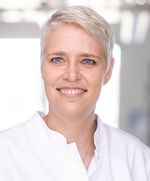
Title of the publication: "The effect of Rho Kinase inhibition on corneal nerve regeneration in vitro and in vivo"
Authors: Sonja Mertsch, Inga Neumann, Cosima Rose, Marc Schargus, Gerd Geerling, Stefan Schrader
Division, Department or University Hospital: Department of Ophthalmology, Department for Human Medicine
Journal: The Ocular Surface, Aug 2021, in press, available online 19 August 2021 doi: 10.1016/j.jtos.2021.08.011; IF 12.336 (2019)
Summary of the background, research question and significance of the publication: Neurotrophic keratopathy (NK) is a degenerative corneal disease that is based on reduced innervation of the cornea. The underlying causes are manifold and range from viral infectious diseases (e.g. herpes keratitis) to neurosurgical interventions, surgical procedures on the cornea and systemic diseases such as diabetes mellitus. Despite the basic regenerative potential of peripheral nerve fibres, sufficient re-innervation of the cornea rarely takes place, which can often lead to persistent corneal ulcers and, in severe cases, to blindness. Previous symptomatic therapies focussed on intensive surface wetting and covering with amniotic membrane. Since 2017, rNGF has been available as a curative treatment option for the first time. However, due to the high costs (approx. €14,000), this is only used in the most severe cases. Our understanding of the underlying mechanisms of NK is still incomplete and the need for alternative curative forms of therapy is very high.
In this publication, we were able to demonstrate for the first time the positive influence of Rho kinase (ROCK) inhibition on the regeneration of damaged corneal nerves in vitro and in vivo. A novel 3D cornea model was established, which provides an in vivo-like environment for the nerve cells. The results were comparable to those of conventional 2D experiments and in vivo experiments. In addition, confocal microscopy (HRT-III) was used to track the time course of nerve regeneration over 28 days in the same animals. In addition to the functional analyses, signalling pathways were investigated by qrtPCR to uncover underlying mechanisms of increased regeneration.
In summary, in this publication we have established a new 3D model for nerve regeneration as well as confocal microscopy in a mouse model and were thus able to demonstrate the regenerative effect of the ROCK inhibitor on damaged nerve fibres. This is a clinically very promising approach for a novel curative therapy of NK and is also particularly relevant as ROCK inhibitors (ripasudil, netarsudil) are already approved in Japan and the USA for the treatment of glaucoma, which significantly simplifies a possible clinical translation of the project.
About the award winner: Dr Sonja Mertsch has headed the Laboratory for Experimental Ophthalmology at the University Clinic for Ophthalmology in Oldenburg since December 2018. Her research focuses on corneal nerve regeneration and the reconstruction and regeneration of ocular surfaces and adnexa. Dr Sonja Mertsch studied biology at the WWU Münster and completed her doctorate at the Institute of Neuropathology Münster on molecular mechanisms of tumour cell migration.
Hermine Heusler-Edenhuizen Prize - winter term 2020/2021:
Daniel Hölle and Juan Felipe Quiñones Sánchez
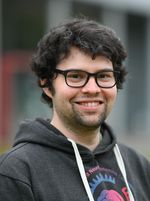
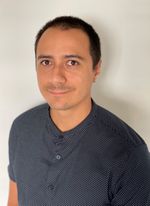
Daniel Hölle
Title of the publication: "Mobile ear-EEG to study auditory attention in everyday life"
Authors: Daniel Hölle, Joost Meekes, Martin G. Bleichner
Division, Department or University Hospital: Neurophysiology of Everyday Life (Emmy Noether Group), Department of Psychology
Journal: Behaviour Research Methods (2021), Volume & Pages TBD
Summary of background, research question and significance of the publication: The majority of neurological studies on auditory perception take place in controlled laboratory conditions. However, the extent to which these research results can be transferred to complex everyday situations is unclear. Our study was the first to record electrophysiological activity of subjects for a duration of 6 hours in everyday life. Our aim was to show that such long-term recordings are technically possible and that the resulting data can be interpreted. To this end, we built a prototype that allows electrophysiological activity to be recorded at the ear and sounds to be presented simultaneously via headphones worn around the neck. We used a smartphone worn on the arm for the recording and sound presentation. Our subjects worked on a familiar auditory paradigm (oddball experiment) for the entire duration of the experiment while going about their normal office work. The subjects were free to move around, e.g. go to the canteen and eat, drink coffee or talk to colleagues. In these everyday recordings, we were able to measure the expected brain responses and thus demonstrate the feasibility of such recordings. So far, there is no comparable study that has conducted such long-term recordings with minimal experimental control in everyday life. This work is a crucial step for further studies in everyday life that will allow us to explore neurophysiological principles outside the laboratory.
About the award winner: Daniel Hölle is a doctoral student in the "Neurophysiology of Everyday Life" group in the Department of Psychology in Oldenburg. He is researching the topic of noise sensitivity and noise processing in everyday life.
Juan Felipe Quiñones Sánchez
Title of the publication: "Nature and nurture shape structural connectivity in the face processing brain network"
Authors: Juan Felipe Quiñones Sánchez, Dr Xinyang Liu (until february 2021), Dr Changsong Zhou, Prof. Dr Andrea Hildebrandt
Division, Department or University Hospital: Department of Psychology, Psychological Methodology and Statistics
Journal: NeuroImage, 2021,229, 117736
Summary of background, research question and significance of the publication: The published article is the result of a research project investigating the environmental and genetic contributions to structural connectivity among face-processing areas in the brain. The ontogeny of face processing abilities has been a subject of debate among researchers who have claimed environmental or genetic prevalence. Both at the behavioural and functional levels, several studies have addressed this topic and yielded heterogeneous results. Our main goal was to build up on this debate by assessing how nature and nurture contribute to fractional anisotropy in the structural pathways linking a well-documented set of face-processing areas in the brain. To do so, we made use of probabilistic tractography and structural equation models for twin data. Our results indicate that though small, there are significant genetic effects that account for individual differences in the structural face network. We further highlight that such effects are exclusive for the structural face network and thus, additional to well-studied genetic effects for general white matter. High uniqueness estimates resulting from statistical modelling emphasise the importance of individual-specific effects including measurement error. Ultimately, our findings are of great relevance, as they: 1. for the first time address the ontogenetic factors responsible for the structural basis of the face processing network. 2. identify significant genetic effects specific to this subsystem. 3. provide statistical background for further studies exploring the components of unique effects. The reported findings additionally entail great methodological achievements, namely a very large sample size for neuroimaging studies and two different methods for the definition of regions of interest for further fibre tract reconstruction.
About the award winner: Juan Felipe Quiñones Sánchez studied psychology in Bogota, Colombia, and later enrolled in the Master's programme in Neurocognitive Psychology at the University of Oldenburg, which led to the submitted publication. He is currently a doctoral candidate in the Department of Psychological Methodology and Statistics at the Department of Psychology.
Hermine Heusler Edenhuizen Prize - summer semester 2020:
Anne Gläser

Title of the publication: "Identification of Brain-Specific Treatment Effects in NPC1 Disease by Focusing on Cellular and Molecular Changes of Sphingosine-1-Phosphate Metabolism" Authors: Anne Gläser, Franziska Hammerl, Markus H. Gräler, Sina M. Coldeway, Christin Völker, and many more.
Division, Department or University Hospital: Department of Anatomy, Department for Human Medicine Journal: International Journal of Molecular Sciences, Year: 2020, Volume: 21
Summary of background, research question and significance of the publication: Niemann-Pick type C1 (NPC1) is a lysosomal storage disorder, inherited as an autosomal-recessive trait. Mutations in the Npc1 gene result in malfunction of the NPC1 protein, leading to an accumulation of unesterified cholesterol and glycosphingolipids. Beside visceral symptoms like hepatosplenomegaly, severe neurological symptoms such as ataxia occur. Here, we analysed the sphingosine-1-phosphate (S1P)/S1P receptor (S1PR) axis in different brain regions of Npc1-/- mice and evaluated specific effects of treatment with 2-hydroxypropyl-β-cyclodextrin (HPβCD) together with the iminosugar miglustat. Using high-performance thin-layer chromatography (HPTLC), mass spectrometry, quantitative real-time PCR (qRT-PCR) and western blot analyses, we studied lipid metabolism in an NPC1 mouse model and human skin fibroblasts. Lipid analyses showed disrupted S1P metabolism in Npc1-/- mice in all brain regions, together with distinct changes in S1pr3/S1PR3 and S1pr5/S1PR5 expression. Brains of Npc1-/- mice showed only weak treatment effects. However, side effects of the treatment were observed in Npc1+/+ mice. The S1P/S1PR axis seems to be involved in NPC1 pathology, showing only weak treatment effects in mouse brain. S1pr expression appears to be affected in human fibroblasts, induced pluripotent stem cells (iPSCs)-derived neural progenitor, and neuronal differentiated cells. Nevertheless, treatment-induced side effects make examination of further treatment strategies indispensable.
About the award winner: Anne Gläser is a doctoral student at the University of Oldenburg in the Department of Anatomy. She is working on analysing tissue-specific treatment effects in the lysosomal lipid storage disease Niemann-Pick type C1. She is currently finalising her doctoral thesis and would like to remain active in the field of research.
Hermine Heusler-Edenhuizen Prize - winter semester 2019/2020:
Dr. Florian Kasten
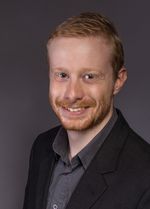
Title of the publication: "Integrating electric field modelling and neuroimaging to explain inter-individual variability of tACS effects"
Authors: Kasten Florian, H; Duecker, Katharina; Maack, Marike C; Meiser Arnd; Herrmann, Christoph S. Division, Department or University Hospital: Division of General Psychology, Department of Psychology Journal: Nature Communications, 2019, 10, 1-11
Summary of the background, research question and significance of the publication: Non-invasive transcranial direct/alternating current stimulation (tDCS/tACS) offers a wide range of potential applications for future therapy of neurological and psychiatric diseases as well as for basic neuroscientific research. transcranial direct/alternating current stimulation (tDCS/tACS) offers a wide range of potential applications for the future treatment of neurological and psychiatric diseases, as well as for basic neuroscientific research. For example, tACS can be used to influence the frequency and amplitude of brain oscillations. However, the effects have proven to be relatively weak and variable in the past. Some critics question the effectiveness of the procedure in general and suspect peripheral physiological mechanisms behind the stimulation effects (e.g. stimulation of retinal or cutaneous nerve cells).the paper presented here investigated the extent to which the strength of tACS effects can be predicted by differences in brain anatomy and the resulting differences in the electric fields induced in the brain. The results indicate that a considerable proportion of the variability of the stimulation effect can be explained by these inter-individual differences and provide important insights for the future application of the method. The existence of a dose-response relationship between the electric field in the brain and the stimulation effect can be seen as evidence that the mechanisms of action of the procedure are located in the brain and are not caused by peripheral physiological mechanisms. Furthermore, the results indicate that the effectiveness of the stimulation can be significantly increased through individualised stimulation protocols, which would benefit therapeutic application in particular. Finally, the paper presents a new approach to analysing the effects of electrical brain stimulation. These are often analysed using simple mean value comparisons. However, such statistical models are subject to the implicit assumption that stimulation produces relatively consistent effects across all subjects. A test for the presence of dose-response correlations, on the other hand, explicitly includes the fact that some individuals show weaker or no effects if the selected stimulation protocol is unsuitable. This makes the model a more accurate representation of the underlying mechanisms of action, and also makes it more difficult to reconcile such correlations with alternative explanations such as placebo effects, making the model better able to control for such confounding.
About the award winner: Dr Florian H. Kasten studied the international master's degree course "Neurocognitive Psychology" at the University of Oldenburg, where he completed his doctorate in psychology on the physiological and behavioural effects of transcranial alternating current stimulation. He is currently working as a post-doctoral researcher in the Department of General Psychology.
Hermine Heusler-Edenhuizen Prize - summer semester 2019:
Saskia Breuel

Title of the publication: "Combining Engineered U1 snRNA and Antisense Oligonucleotides to Improve the Treatment of a BBS1 Splice Site Mutation"
Authors: Saskia Breuel, Mariann Vorm, Anja U. Bräuer, Marta Owczarek-Lipska and John Neidhardt Division, Department or University Hospital: Department of Human Genetics, Department for Human Medicine Journal: Molecular Therapy Nucleic Acids, 2019, Volume 18, pp. 123-130
Summary of the background, research question and significance of the publication: Retinal degenerations (RD) are rare hereditary diseases that often lead to blindness due to the progressive loss of photoreceptors and thus impair the patient's quality of life. Around 1 in 3000 individuals worldwide are affected by RD and the associated enormous socio-economic problems. Due to the genetic heterogeneity, therapeutic treatment options are rarely available or only have a marginal effect. The development of new therapeutic approaches is therefore urgently needed. The researchers investigated a family in which one member was affected by the disease retinitis pigmentosa, which belongs to the group of retinal degenerations. At the molecular level, the disease is caused by a mutation that leads to an altered splicing pattern of the gene transcript. As a result, the amount of the normal gene product is insufficient for the maintenance and function of the photoreceptor cells and these die over time. In their paper "Combining engineered U1 snRNA and antisense oligonucleotides to improve the treatment of a BBS1 splice site mutation", they developed a new, first successful therapeutic approach using patient-derived fibroblasts to overcome the deleterious effects of the mutation. They combined two techniques, both of which increased the amount of correctly spliced transcript and thus synergistically improved the therapeutic effect. This combination therapy is significantly more efficient than a technique previously published by the Human Genetics Division of the School of Medicine and Health Science at the University of Oldenburg. They were also able to show with their results that this new therapeutic approach does not cause an increase in cell death in the treated patient cells and is therefore very safe.
About the award winner: Saskia Breuel is a biology student at the University of Oldenburg and completed her Master's thesis on "Gene therapeutic correction of mutation-induced BBS1 splicing defects using AONs and mutation-adapted U1 snRNA" in the Department of Human Genetics at School VI with a 1.0. She completed her Bachelor's thesis in the Department of Neurogenetics.
Hermine Heusler-Edenhuizen Prize - winter semester 2018/2019:
Christian Lins

Publication title: "Cardiopulmonary resuscitation quality parameters from motion capture data using Differential Evolution fitting of sinusoids"
Authors: Christian Lins, Daniel Eckhoff, Andreas Klausen, Sandra Hellmers, Andreas Hein and Sebastian Fudickar
Division, Department or University Hospital: Department of Assistance Systems and Medical Technology, Department of Health Services Research
Journal: Applied Soft Computing, June 2019, page 300 to 309
Summary of background, research question and significance of the publication: Cardiopulmonary resuscitation (CPR) is an important countermeasure when people suffer a sudden cardiac infarction/arrest. First aid is usually initially provided by medical laypersons, so a broad knowledge of CPR among the population is crucial. High-quality CPR is only possible with regular training, for which technical aids are also used. This work describes a robust and new approach to innovative training devices for cardiopulmonary resuscitation. While previous training devices are usually stationary and physically heavy training dummies, the approach described in this paper uses a mobile RGB-D camera (such as the Microsoft Kinect), which makes it possible to capture the entire scene. External measurements, as in our approach, can evaluate the scene and the behaviour of the actors, especially for the training of professional rescuers. However, external systems can also include additional observations in the quality assessments for the training of laypersons, such as the posture of the trainee's upper body and arms during CPR, which has a significant influence on the trainee's endurance and fatigue. Our method continuously adapts the movement data to a sinusoidal model, which can then derive the heart pressure frequency and depth of indentation. In a first step, we evaluated the recognition of these most important quality factors of cardiac massage based on motion data from the Kinect sensor. We were able to show that the approach is feasible and that the observed compression frequency deviates only minimally from the gold standard. With these results, cost-effective CPR training devices can now be developed for widespread use. In particular, regions without suitable training facilities could benefit from practical, cost-effective training technologies. With the increasing use of AI hardware in smartphones, it will also be possible to integrate our method into future smartphones as an app. The smartphone thus becomes a personal resuscitation training device. Integration into defibrillators is also conceivable; an integrated camera could monitor CPR and provide acoustic cues. This would also make it possible to support a rescuer in real-life operations.
About the award winner: Christian Lins studied Media Informatics and Computing Science at Osnabrück University of Applied Sciences (Dipl.-Inf. (FH) in 2009, M.Sc. in 2012) and has been a doctoral candidate at the OFFIS Institute and the Assistance Systems and Medical Technology department since 2013. As part of his doctoral thesis, he is working on the evolutionary optimisation of classification models. He is also involved in the university's doctoral student representation.
Hermine Heusler-Edenhuizen Prize - summer semester 2018:
Dr. Stephanie Rosemann

Title of the publication: "Audio-visual speech in age-related hearing loss: Stronger integration and increased frontal lobe recruitment"
Authors: Dr Stephanie Rosemann and Prof. Dr Christiane M. Thiel
Division, Department or University Hospital: Biological Psychology, Department of Psychology Journal: NeuroImage, 2018, 175, page 425-437
Summary of the background, research question and significance of the publication: A natural consequence of ageing is hearing impairment, which predominantly affects the high frequencies. This hearing loss impairs the perception of speech, especially under difficult conditions, for example due to background noise. In everyday life, however, we have additional visual information that can improve speech perception, for example through lip-reading. Previous research has shown that hearing impairment in old age leads to changes in auditory perception and even neuronal changes in the auditory cortex. The extent to which hearing loss affects the processing of audio-visual speech is not yet known. Therefore, in this study we investigated the influence of age-related untreated hearing impairment on audio-visual speech perception using functional magnetic resonance imaging (fMRI). This is the first fMRI study to investigate audio-visual speech perception in mild to moderate hearing impairment in old age. We were able to show that hearing-impaired subjects exhibit stronger audio-visual integration and that they show additional activation of the frontal cortex for the processing of difficult speech stimuli. This is presumably related to the increased effort required by these subjects to solve the task. It is also interesting to note that these changes are significantly associated with the severity of the hearing loss, i.e. a more severe hearing loss leads to greater integration and higher activation of the frontal cortex. Thus, we show for the first time that even mild to moderate hearing loss leads to changes in the perception and neural processing of audio-visual speech and that these changes are related to the severity of hearing loss. From a clinical perspective, these findings are highly relevant as these changes can influence the fitting of a hearing aid. In addition, hearing loss plays a major role in our ageing society - over 40% of adults over the age of 65 are affected by hearing impairment (von Gablenz & Holube, 2015).
About the award winner: In her doctorate at the University of Bremen, she focussed on auditory and visual disorders that occur after a stroke. Stephanie Rosemann has been a postdoctoral researcher in the Department of Biological Psychology at the University of Oldenburg since 2016. Her research here focuses on neuronal changes in hearing impairment in old age.


